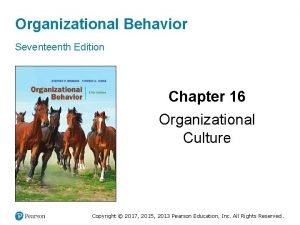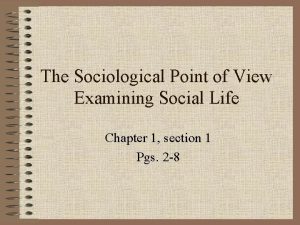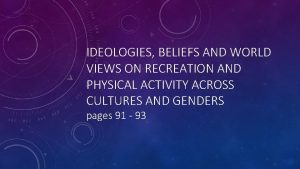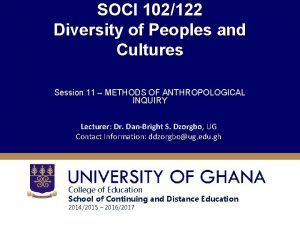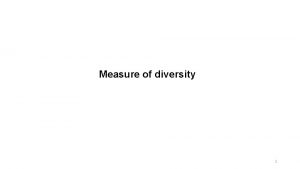SOCI 102122 DIVERSITY OF PEOPLES AND CULTURES Session













- Slides: 13

SOCI 102/122 DIVERSITY OF PEOPLES AND CULTURES Session 2 – Environment and Human Adaptability Lecturer: Dr. Dan-Bright S. Dzorgbo, UG Contact Information: ddzorgbo@ug. edu. gh College of Education School of Continuing and Distance Education 2014/2015 – 2016/2017

Session Overview Introduction This session explores the relationship between types of physical environments and human adaptability. Objectives At the end of the session, the student will be able to: • Define what environment is • Develop knowledge on different physical environments that humans find themselves in • Have knowledge about the possibilities and challenges these environments offer humans • Explain how humans have adapted to these environments Dr. Dan-Bright S. Dzorgbo Slide 2

Reading list • Assimeng, M. (1999), Social Structure of Ghana, Tema, Ghana Publishing Corporation. • Kottak, C. P. (2004), Cultural Anthropology, Boston, Mc. Graw Hill Corporation. • Kottak, C. P. (2004), Anthropology: The Exploration of Human Diversity, Boston, Mc. Graw Hill Corporation. • Nolan, P. & G. Lenski, (2004 or any of the newer editions), Human Societies: An introduction to macrosociology, Boulder Paradigm Publishers. • Nukunya, G. K. (2006), Tradition and change in Ghana: An introduction to sociology, Accra, Ghana University Press. • Sanderson, S. K. & A. S. Alderson (2005 or its newer editions), World societies: the evolution of human life, Boston, Pearson Education Inc. Dr. Dan-Bright S. Dzorgbo, Sociology Dept. UG Slide 3

Topic One: Definition of the Environment • The term environment refers to “everything that is external to a specified population and that has any affect on it” (Nolan and Lenski, 2006: 10). • Animals have their environments and so do humans. For example, chimpanzees, gorillas and monkeys have the tropical forests and other plants and animals on which they depend on or feed on as their environments • Some animals also have rivers, lakes, lagoons and the seas as their environment Dr. Dan-Bright S. Dzorgbo Slide 4

Definition of the Environment (cont’d) • For human societies as Nolan and Lenski (2006) explain it, our environments include such things as the soils minerals and water resources, climate, air, terrains, plants, animals and other features of the territories we occupy. • These environments also include other human societies that our members come into contact with. • Therefore for a given human society, its environment includes both the physical and the social world. Dr. Dan-Bright S. Dzorgbo Slide 5

Topic Two: Differences in Environment • Human beings across the world find themselves in different types of environments. • There are some people who live in large political units such as Africa, others in Europe, Asia, United States of America, Latin America, the Middle East, etc. • However, these political units possess different environmental characteristics. • In terms of climatic conditions, some are hot and some are cold, they experience different amounts of rainfall and have different types of vegetation, etc. • The soils and minerals as well as water resources are of the human environment are different. • Simply put the human environment is highly diversified and keeps changing Dr. Dan-Bright S. Dzorgbo Slide 6

Topic Three: Possibilities and Challenges • The differences in environments mean that the environments presents humanity opportunities as well as challenges • For some societies, particularly the traditional ones, or the so-called primitive societies, the environments (or to be precise their biophysical environments) provided almost all they needed but they also contained wild animals that posed threats to their existence Dr. Dan-Bright S. Dzorgbo Slide 7

Possibilities and Challenges (cont’d) • Some biophysical environments offer opportunity for more diseases and pollutions than others • Some environments offer much more known mineral resources than others • Some experience more rainfall that others and others are just deserts. • The social environment also poses opportunities and challenges. • Through contact, different societies gain from each other, goods and ideas which become mutually beneficial to them Dr. Dan-Bright S. Dzorgbo Slide 8

Possibilities and Challenges (cont’d) • • • However, the social environment can be a threat to the survival or viability for some societies The interactions among societies also lead to underdevelopment and poverty for others As others societies such as the US and her western allies such as Britain, France, Germany, Japan, Australia, etc. seek to access the resources of other nations to generate and maintain their high standard of material living, they create poverty for the societies in Africa and other parts of the so-called developing world. It can be argued that Africa’s resources are being exploited and looted by wealthy nations and Africans remain poor and trapped in perennial debt and dependency relations with these exploiter nations This social environment or contact is therefore a threat to Africa’s viability and progress. Throughout history and in this 21 st century some societies, usually the developed and technologically advanced, would even wage war on other societies, leading to death of millions of people, absolute poverty, hunger, internal displacement, homelessness, despair, etc. while they experience peace, stability wealth and material progress Dr. Dan-Bright S. Dzorgbo Slide 9

Topic Four: Human Adaptations to Environments • In order survive, human societies must interact with their respective environments • Some environments are relatively more generous in terms of natural resources than others thus offering human greater possibilities for development. • Those that are less endowed with resources have greater challenges to survive than others • Thus it is often said that the environment to a great extent determines what humans can do—the theory of environmental determinism. For example, if you live near the sea, you are likely to become a fisherman, or if you live in an environment where rainfall is abundant as in the Western and Ashanti regions of Ghana you are likely to grow crops such as cassava, plantain, cocoyam and cocoa which require much rainfall. Dr. Dan-Bright S. Dzorgbo Slide 10

Human Adaptations to Environments (cont’d) • However, if you live in the Northern regions of Ghana where rainfall is low, you are likely to grow cereals such as maize, millet, sorghum, and rear animals—all requiring low rainfall • Eventually these differences translates into different foods and food habits for those in Southern and Northern Ghana. • Thus the environment surely contributes significantly to human diversity Dr. Dan-Bright S. Dzorgbo Slide 11

Human Adaptations to Environments (cont’d) • The environmental determinism idea or theory should however be qualified. • The environment may surely create possibilities and challenges but humans develop both material and non-material culture and so create science and technology that they can use to overcome environmental challenges and constraints • In many parts of the world such as the Sahara desert, and the temperate regions of Canada, Europe, Russia etc. humans experience great environmental challenges in the form of long and extreme cold season, short periods for growing crops, however, through human’s ingenuity, innovativeness and technological advancement, most of these challenges have been overcome and life is bearable than many centuries before. Dr. Dan-Bright S. Dzorgbo Slide 12

Conclusion: Environment and Human Adaptability In this session we have: • defined the environment and distinguished between the biophysical environment and the social environment • provided knowledge on different types physical environments and how they shape the human conditions • learnt that humans need to interact with their environments to secure a living • learnt that environmental conditions and resources provide humans with possibilities and challenges • learnt that the environment to a large extent determines human activity but humans also have the capacity to shape the environment and even overcome some of its constraints Dr. Dan-Bright S. Dzorgbo Slide 13
 Organizational cultures often reflect ________.
Organizational cultures often reflect ________. Nab��dka pr��ce soci��ln�� pracovn��k
Nab��dka pr��ce soci��ln�� pracovn��k Ponuka pr��ce soci��lny pracovn��k
Ponuka pr��ce soci��lny pracovn��k Genetic diversity vs species diversity
Genetic diversity vs species diversity Genetic diversity vs species diversity
Genetic diversity vs species diversity Pre columbian america lesson 1 answers
Pre columbian america lesson 1 answers Many territories and peoples controlled by one government
Many territories and peoples controlled by one government The peoples of north america and mesoamerica
The peoples of north america and mesoamerica What is sociology perspective
What is sociology perspective Recreational activities across cultures and genders
Recreational activities across cultures and genders Chapter 20:12 measuring specific gravity
Chapter 20:12 measuring specific gravity Indulgence versus restraint hofstede
Indulgence versus restraint hofstede Southeastern and gulf cultures
Southeastern and gulf cultures Cultures of the mountains and the sea
Cultures of the mountains and the sea
